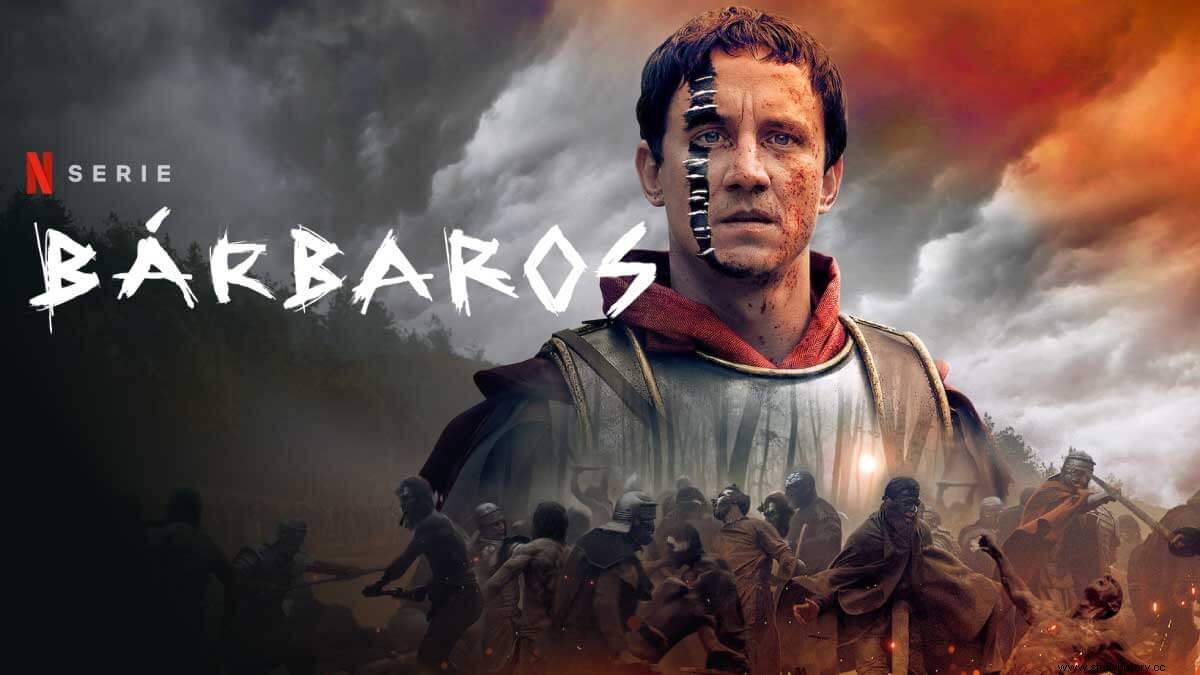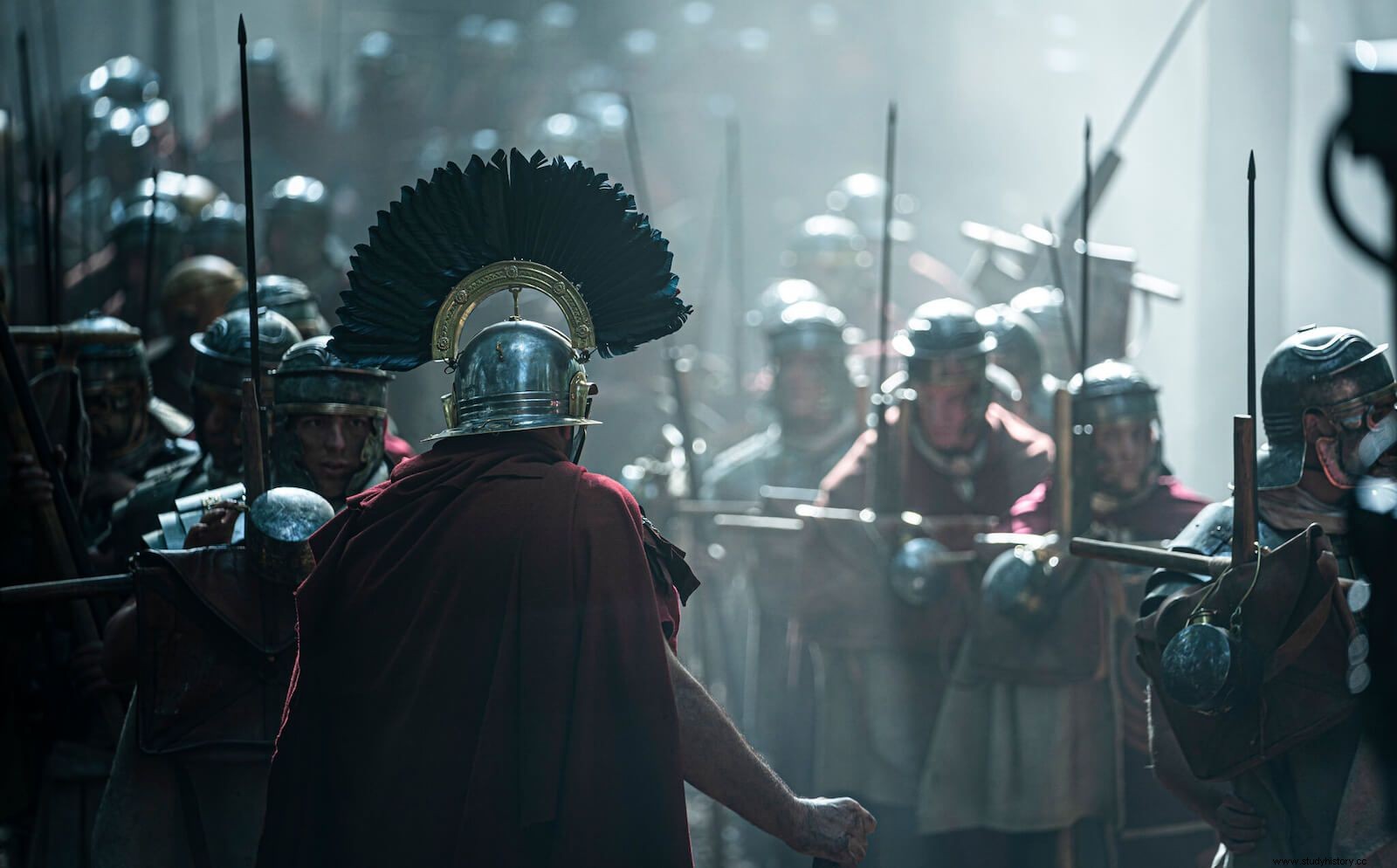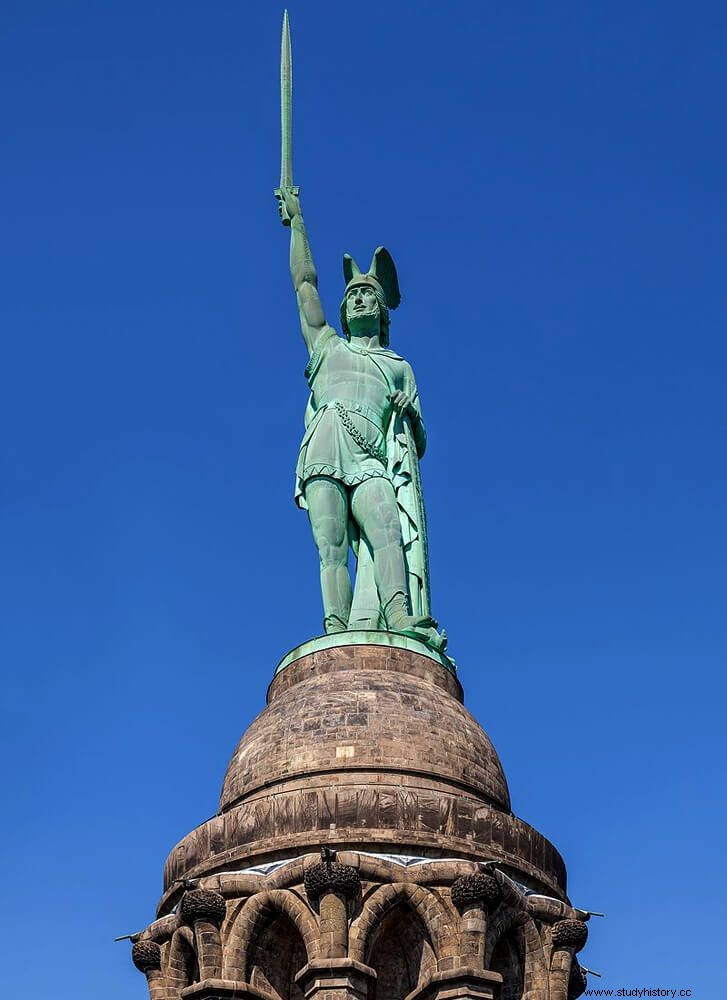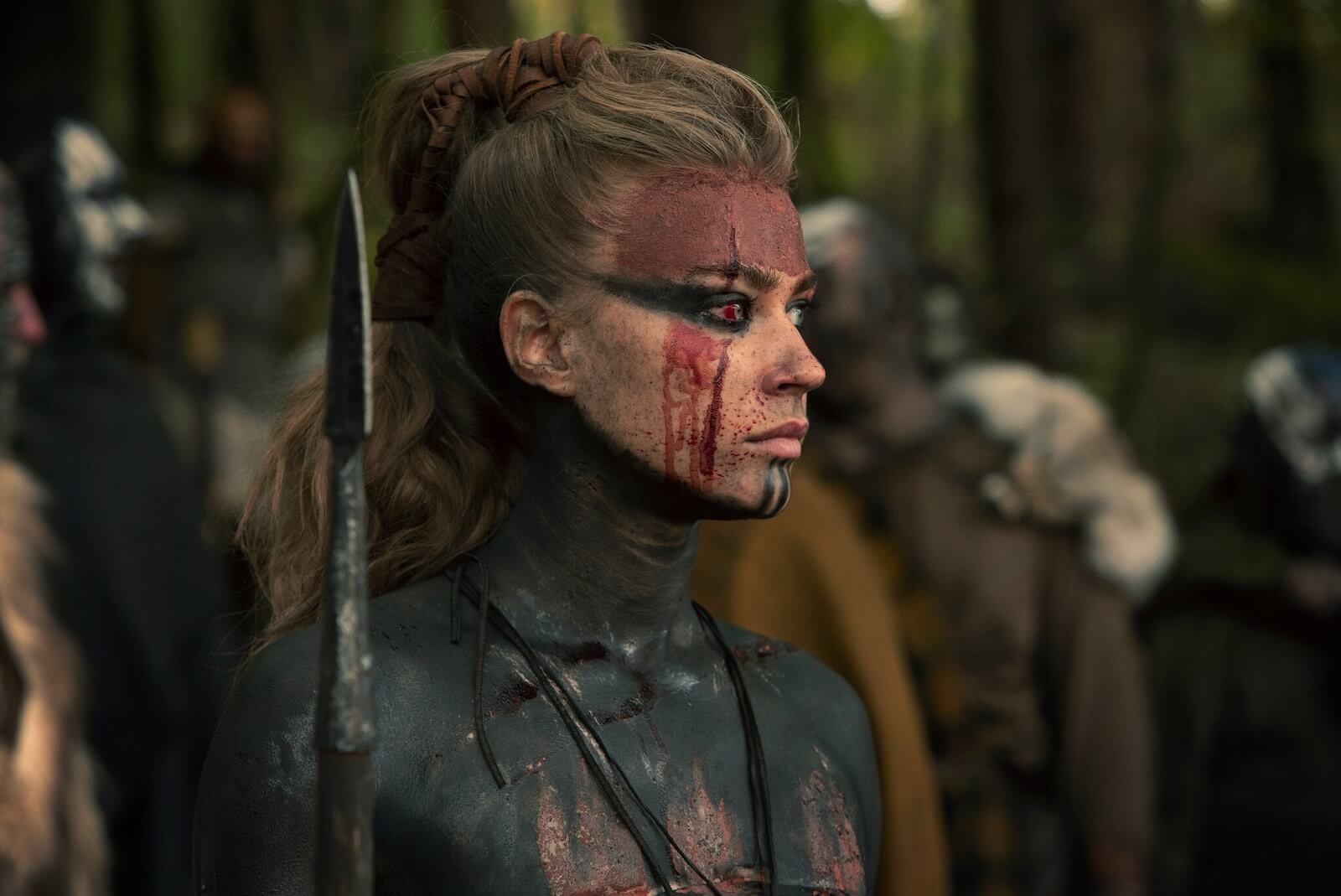
The historical background of the Barbaren series could not be more attractive. A succession of military campaigns, beginning in 12 BC, had given Rome control of the German territory between the Rhine and the Elbe. In 9 AD Publius Quintilius Varus was designated as legate of the Germania Magna with the task of consolidating the Roman administration, which involved establishing a tax system. Among his trusted men was Arminio, commander of auxiliary troops , of Cheruscan origin, whose parents had sent him as a hostage to Rome, where he acquired citizenship and equestrian rank. Arminius managed to persuade various Germanic peoples to acknowledge his leadership and, in September 9 AD, he led Varus' army by trickery into the Saltus Teutoburgensis , a rugged, wooded area north of the Wiehengebirge massif in Lower Saxony, which prevented the long Roman column from fighting in formation. Attacks and ambushes continued for three days until a final desperate fight between a swamp and Kalkriese hill . The XVII, XVIII and XIX legions, along with three a lae of cavalry and five auxiliary cohorts, were annihilated. This defeat was an unmitigated disaster that forced Rome to withdraw to the west of the Rhine, a river axis that, for four centuries, would serve as the border between the Roman Empire and the Barbaricum.
The Teutoburg myth it would take more than a millennium to emerge. At the beginning of the 16th century, Martin Luther considered Hermann – the German version of the Latin Arminius, based on a false etymology – the national symbol that a fragmented people needed in their struggle against Rome. The victory of Teutoburg was attributed a providential character, since it would have made possible the survival of German culture, and with the rise of German nationalism works of fiction multiplied. During the 18th and 19th centuries, "the Liberator" starred in fifty operas and plays, such as Die Hermannsschlacht ("The Battle of Hermann"), composed by Heinrich von Kleist in 1808 as a call to arms against the Napoleonic occupation. Hermann made his big screen debut in 1924 under the original title of Die Hermannschlacht, an epic forged in the patriotic fury of the Weimar Republic. The arrival of the Nazis to power made the powerful German film industry put itself at the service of its ideology. In 1936, the feature film Ewiger Wald ("Eternal Forest") begins with the German victory in Teutoburg and concludes by presenting Nazism as the pinnacle of a long process of national gestation.
Since the fall of the Axis to the present day, Arminius and the Battle of Teutoburg starred in several docudramas with a clear demystifying vocation. Despite the macrohistorical significance attributed to the Varo disaster, current German historiography tends to relativize the independence obtained by the Germans in Teutoburg . The Cheruscan king was unable to unite the tribes for a long time, his relatives assassinated him in 19 AD, three years after being defeated by Germanicus at Idistaviso, and the Roman concept of imperium It included control of satellite territories without the need for military occupation, thanks to a mixture of diplomacy, treaties, commercial links and soft power . The discovery of an ancient battlefield 100 kilometers east of Kalkriese, near Kalefeld, south of Hannover, confirms the Roman military presence deep in the Germania libera early 3rd century AD
Barbaren from Netflix:the return of Arminio
The Netflix series is the first major audiovisual adaptation of this historical character after a 90-year hiatus. At a time characterized by political hypercorrectness and the resurgence of nationalism, moving the C variana lades on the screen seemed to enter a minefield. Undoubtedly, the most notable aspect of the result is the rigor in the recreation of the costumes and weapons , although the Roman panoplies must be dated a few decades later. The scenarios are just as realistic, although limited in number. This turns the action into a continuous swing between the Roman camp and the Cheruscan village, which is repeated until the final climax with hardly any subplots or analepsis (flashbacks ) that alleviate this claustrophobia. Although Barbaren It has a more than acceptable cast and an excellent technical bill, the biggest flaws fall on the script. The narrative events follow each other with hardly any causality, entangled in conflicts between secondary characters that tend to break up a confusing plot that revolves around the love triangle formed by Arminio, his wife Thusnelda, and a fictional character named Folkwin.

In the series, Thusnelda –daughter of Segestes, a Cheruscan nobleman who warned Varo of the impending rebellion – she is Arminio's childhood friend, and will become his wife after an impossible affair with Folkwin. In reality, Thusnelda consented to being "kidnapped" by Arminius after the Battle of Teutoburg, and was later handed over to the Romans by her father, pregnant by her husband, as revenge for an assassination attempt orchestrated by him (Tac. Ann. 1.55-57). The historical licenses do not help to strengthen the plot, quite the contrary. The revolt is triggered by the unlikely theft of a legionary eagle from the Principia from the Varo camp. Folkwin, who insinuates himself as the protagonist, ends up fading away in the last two chapters. Thusnelda's seer status serves as deus ex machina so that her husband unites the Germans under his leadership. Arminius becomes the adopted son of Quintilio Varo, which, although it accentuates an interesting internal conflict, does not help explain his betrayal.
The Manichaeism of the characters is evident from the first scene. In The Script , Robert McKee points out the need to provide the antagonists with a coherent psychology and more believable motivations than the mere desire to do evil. In Barbaren the characterization of the antagonists has the subtlety of a Chuck Norris movie. Romans only interact with barbarians abusively either verbal or physical. They hate rebels for their rebelliousness and despise collaborators for their subservience. Sometimes they surprise us with some vestige of humanity, such as Varo's affection for Arminio, but from the first moment they make merits so that no one regrets their holocaust in Teutoburg.
Quintilio Varus was certainly not a paragon of virtue . Between the years 6 and 4 B.C. He held the position of governor of Syria, a province that, according to Veleyo Patérculo (II.117,3), "received rich while he was poor and left poor while he was rich" after solving a revolt in Judea with the crucifixion of two thousand Jews. He does not seem the best candidate to establish a tax system, and yet Arminio's betrayal was at the service of the same personal ambitions that led to his assassination. He is not the only one embellished by fiction. By the turn of the era, the Germans had been threatening the Celts for a century; the portrait of villagers defenseless against Roman militarism is as far removed from reality as the rude nobility of those who live outside the pernicious influence of civilization.
The myth of the noble savage in history
The myth of the “noble savage” has deep roots. The first account of the Germanic peoples is the work of the historian Publius Cornelius Tacitus, who dedicates a short treatise entitled Germania to them. and various passages in the Annals of him , our best source to learn about Arminio's rebellion after the work of Veleyo Patérculo. Tacitus presents the querusco as the "liberator of Germania" and his people as an egalitarian society, in which all decisions are decided in community, which ignores usury, values the opinion of women, and surprises by its sobriety . The Germans, according to Tacitus, had such high morals that they did not need laws.
The events of the IV-V centuries do not seem to confirm this contempt for material goods, nor does Germanic law corroborate this privileged position of women. When writing his work, Tacitus does not have in mind so much the Germanic virtues as the corruption of Rome itself, the loss of power of the Senate, the ostentation of its ruling class and conquests driven by spurious interests; the supposed deviation from a state of natural goodness. This opinion was not very popular in Rome. The dichotomy between civilization and barbarism is a common theme in classical literature; the portrait of a violent and backward alterity was an inseparable part of Roman identity .

Already in the Enlightenment, the paradigms of the bellicose barbarian and the noble savage they cemented, respectively, the political thought of Thomas Hobbes and Jean-Jacques Rousseau . In an age of construction of national narratives, pseudoscientific racism and colonial expansion, Europeans appealed to one myth or another for convenience. Both the Völkisch movement Like Nazism, they willingly assumed that proverbial nobility of the primitive Germans. From the prism of Aryan superiority, it was difficult to explain that the "cradles of civilization" had arisen among the untermenschen . The noble savage was a more than acceptable substitute and, therefore, the Reichsführer Heinrich Himmler wanted to seize the codices of Germania .
Cinema and series. Between cliché and political correctness
Two world wars and the horrors of the two great -isms of the 20th century pulverized faith in the progress of Western Modernity and spread the Rousseau myth. Anthropologists such as Harry Turney-High or Quincy Wright began to highlight the sporadic and ritual nature of tribal clashes, or the egalitarianism of hunter-gatherer societies. Under the shadow of French postmodernity, postcolonial studies emerged. In Orientalism , Edward Saïd describes the way in which Europeans projected a series of anti-values onto Asians and Africans to legitimize their colonial regime, perpetuating stereotypes about the violent, irrational, sensual and tyranny-prone character of the "orientals" in opposition to the rationalism of West.
The first audiovisual manifestation of this paradigm shift occurred in American cinema , hegemonic after the end of World War II, with its own history. The western genre , which had previously narrated the colonization of a virgin territory and the "pacification" of the natives, moved to works such as Blue Soldier (1970), Little Big Man (1970) or Dances with Wolves (1990). Over time, the necessary dignity of indigenous peoples has ended up inverting the moral categories of a simplistic dualism and insistently repeats the same plot pattern:peaceful natives in perpetual ecological harmony whose bucolic existence is abruptly interrupted by aggression of Modernity (for a complete and balanced view of the Indian Wars, see The earth cries , by Peter Cozzens). This paradigm is uncritically transferred to any historical scenario, sometimes under the alibi that “History is written by the victors”. The conflict no longer resides so much in genocide or violent submission but rather in preserving an ancestral way of life in the face of acculturation. Set in the Satsuma Rebellion of 1877, The Last Samurai (2003) transforms a revolt of feudal lords in the face of the loss of their class privileges, within the transformation of Japan into a modern state, into a beatific indigenist movement and a metaphor for the Indian genocide. Only Apocalypto (2006) by conservative Mel Gibson is an exception to this trend.
It was a matter of time before this cliché moved to Rome, aesthetic inspiration for nationalisms of all kinds and bases of Western civilization. The first babble of this new discourse can be sensed in the series Spartacus , although without a doubt the most outrageous peplum indigenista be Barbarians, the awakening (2016) , a History Channel docudrama that presents the Roman world as a slave, capitalist and colonial dystopia. Carthaginians, Lusitanians and Visigoths are part of the same human category, wars and conquests over seven centuries are included in a common cause, and Attila enters Gaul to avenge Hannibal's defeat in Zama. A carousel of interviews with alleged experts serves to support this delusional thesis, a mirror image of some identity politics who try to group under the same banner a multitude of ethnic, racial and gender identities by mere opposition.

The Manichaeism of Barbaren it does not reflect a stale German nationalism, but the commonplaces of contemporary historical cinema. A few clichés that, judging by the reception of the series, can easily pass through the sieve of political correctness and delight those who consider the Germania libera as a sanctuary of the quintessential Aryan. This paradox shows that the mythology of ethno-nationalism It hardly differs, in its ideological structure, from postmodern indigenismo:both defend idyllic societies whose primordial purity must be preserved from any external contamination.
The final reflection that the writers of Barbaren put into the mouth of Arminio, sitting before the severed head of Varo, is that the barbarians fight to defend their culture and way of life . Watching, moments later, some Germans gobbling up the recently amputated genitals of a legionnaire, one cannot help but wonder if that way of life really deserves to be defended. In that sense, the controlling idea that the creators of the series want to convey is hopelessly shipwrecked.
In conclusion
Perhaps the unanswered question is, did the noble savage really exist? ? In his controversial War before civilization (1996), Lawrence H. Keeley shows that tribal conflicts are up to twenty times more deadly than European wars in the 20th century , either in the percentage of the population killed in a conflict or the annual average of deaths over the total demographics. The most common forms of aggression are incursions into enemy territory, followed by more or less ritualized battles and massacres to exterminate an entire group. Ethnography documents that the Dugum Dani of New Guinea participated in seven battles and nine raids in less than six months; a Yanomamo village in the Amazon was robbed 25 times in just over a year. These raids could kill 5-15% of a village's inhabitants. In Crow Creek, South Dakota, archaeologists found a mass grave with the remains of more than 500 men, women and children massacred and mutilated in an attack on the town in which more than half the population died, a century and a half earlier. of the arrival of Columbus.
The noble savage incarnate may have been the Moriori, the natives of the Chatham Islands, 500 miles southeast of New Zealand. This isolated population of barely two thousand individuals made all decisions in community and was governed by a principle of non-violence called the Nunuku law. If coming to blows was unavoidable, litigants could hit each other with thumbsticks in duels to the first blood. On November 19, 1835, a ship arrived from New Zealand with 500 Maori, followed by another, on December 5, with 400 more. The Moriori met to decide how to act in the face of the invasion. Some young people pointed out that their customs were designed to preserve internal peace; They must take up arms, or face certain death. The elders disagreed:Nunuku's law was a moral imperative. The Moriori gave up the fight and, in the words of one witness, the Maori “began killing us like sheep wherever they found us” . The corpses were consumed in acts of cannibalism, the survivors enslaved and forbidden to mate; most died of illness, overwork, or discouragement. By 1863 only a hundred Moriori were still alive.
Bibliography
- Abdale, J. R. (2016) Four Days in September:The Battle of Teutoburg. Barnsley:Pen &Sword Military.
- Esteban Rivas, A. R. (2014) Águilas en Germania. The campaigns of Varus and Germanicus on the Rhine. Zaragoza:HRM Editions.
- Keeley, L. H. (1996) War before civilization: The Myth of the Peaceful Savage . Oxford:Oxford University Press.
- Krebs, C. B. (2011) The most dangerous book:The Germania of Tacitus, from the Roman Empire to the Third Reich. Barcelona:Editorial Critica.
- Winkler, M. M. (2015) Arminius the Liberator:Myth and Ideology . Oxford:Oxford University Press.
